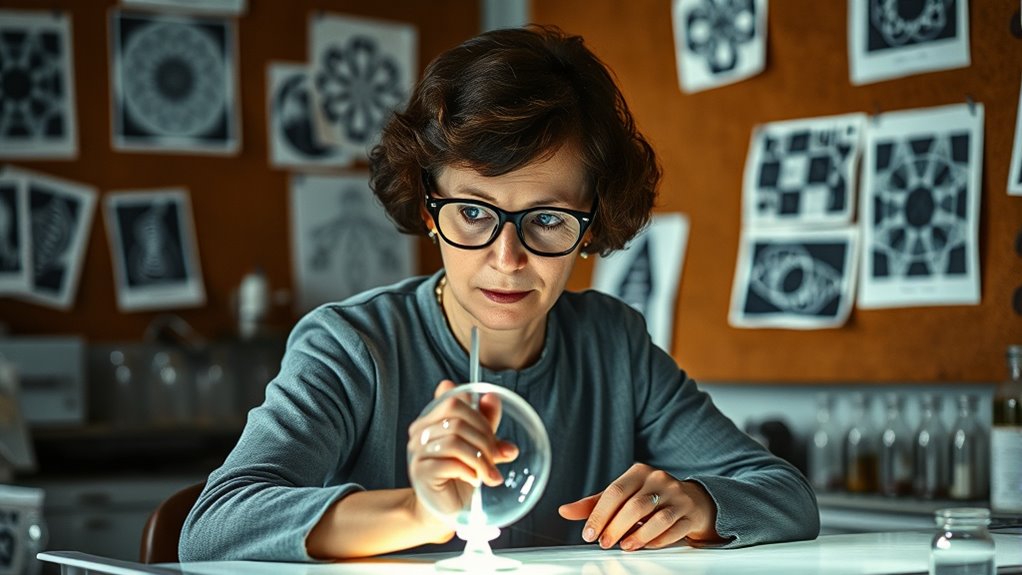Rosalind Franklin’s groundbreaking X-ray diffraction work gave us the critical images that revealed DNA’s double helix. You see, her Photograph 51 showed the helical pattern and the organized, double-stranded structure. Her meticulous research provided essential clues that allowed Watson and Crick to develop their DNA model. If you keep exploring, you’ll discover how her contributions revolutionized genetics and paved the way for molecular biology as we understand it today.
Key Takeaways
- Rosalind Franklin used X-ray diffraction to produce Photograph 51, revealing DNA’s helical structure.
- Her meticulous X-ray images provided critical evidence for the double helix model of DNA.
- Franklin’s work laid the foundation for Watson and Crick’s discovery of DNA’s structure.
- Her research demonstrated DNA’s organized, double-stranded helical form, crucial for understanding genetic replication.
- Franklin’s pioneering techniques and insights significantly advanced molecular biology and genetics.

Rosalind Franklin was a pioneering scientist whose work with X-ray diffraction revealed critical insights into the structure of DNA. You mightn’t realize it, but her meticulous research laid the groundwork for understanding how genetic information is stored and transmitted. Her expertise in X-ray crystallography allowed her to capture images that exposed the DNA’s true shape, providing essential clues about its structure.
Rosalind Franklin’s X-ray diffraction work revealed DNA’s true shape, laying the foundation for genetic understanding.
Her work was vital because it helped resolve the mystery of DNA’s double helix. She captured Photograph 51, an X-ray image that showed a distinct pattern indicative of a helical structure. This image was crucial because it revealed that DNA isn’t just a random coil but a well-organized, double-stranded helix.
Her precision and attention to detail in interpreting these diffraction patterns gave scientists like Watson and Crick the information they needed to build their famous model. Without her contributions, the discovery of the DNA structure might’ve taken much longer or been less accurate.
Your understanding of DNA’s structure today is deeply rooted in Franklin’s scientific contributions. She demonstrated that DNA was composed of two strands forming a double helix, with specific spacing between the bases, which explained how genetic information could be copied and passed on.
Her work also highlighted the importance of the sugar-phosphate backbone and the pairing of nitrogenous bases, concepts central to genetics and molecular biology. Franklin’s insights didn’t just solve a puzzle; they opened new avenues for research into genetic inheritance, mutations, and the molecular basis of life itself.
Despite facing significant obstacles, including gender bias and limited recognition during her lifetime, Franklin’s scientific contributions continue to inspire. You can appreciate her as a trailblazer who used X-ray diffraction to unlock the secrets of DNA, transforming biology forever.
Her precise experimental techniques and dedication to uncovering the truth about DNA’s structure exemplify how rigorous science can lead to groundbreaking discoveries. Today, her legacy reminds us that scientific progress often rests on the shoulders of those whose work mightn’t always be immediately celebrated but is nonetheless essential for advancing knowledge.
Her pioneering efforts serve as a testament to the importance of scientific integrity and perseverance in research, illustrating how dedication to truth can lead to revolutionary breakthroughs. Additionally, her work demonstrated the significance of scientific collaboration in achieving major scientific milestones.
Frequently Asked Questions
What Specific Techniques Did Franklin Develop for X-Ray Crystallography?
You should know that Franklin developed advanced techniques for crystal imaging and diffraction pattern analysis, which allowed for clearer, more detailed images of molecular structures.
She refined X-ray crystallography methods by optimizing crystal preparation and exposure, producing high-quality diffraction patterns.
Her meticulous approach helped interpret the patterns accurately, revealing the double helix structure of DNA.
Her techniques revolutionized the field, enabling scientists to uncover complex molecular architectures.
How Did Franklin’S Background Influence Her Scientific Career?
They say “blood runs thicker than water,” and your family influence and educational background shaped your path. Your family valued education, inspiring you to pursue science passionately.
Your rigorous academic training in chemistry and physics provided the skills to excel in X-ray crystallography. This foundation empowered you to make groundbreaking discoveries, proving that your background and support system can propel you toward scientific greatness.
What Challenges Did Franklin Face as a Woman in Science?
As a woman in science, you face significant gender bias and career obstacles that Franklin encountered. She often struggled to gain recognition for her groundbreaking work due to societal expectations and discrimination.
Despite her expertise, she faced limited opportunities and was frequently overlooked or underestimated. These challenges made her journey tougher, but her perseverance and dedication helped her contribute vital insights into DNA’s structure, highlighting her resilience against such barriers.
Were There Any Overlooked Contributions From Franklin During Her Lifetime?
You mightn’t realize it, but Franklin’s contributions were often overlooked during her lifetime, especially regarding women’s recognition in science.
Despite her groundbreaking work, she didn’t receive proper acknowledgment, partly due to the lack of scientific mentorship and biases against women.
Her pivotal role in discovering DNA’s structure was underestimated, highlighting the importance of giving women credit and fostering mentorship to guarantee their achievements are celebrated and remembered accurately.
How Is Franklin’S Work Impacting Modern Genetic Research Today?
Imagine a world where DNA analysis and genetic engineering transform medicine. Franklin’s pioneering work laid the foundation for these advances, revealing DNA’s double helix structure.
Her contributions enable scientists today to decode genetic information, develop gene therapies, and personalize medicine. Without her insights, modern genetics might still be in its infancy.
Her legacy profoundly impacts how we comprehend life, health, and disease, shaping a healthier future for all.
Conclusion
You see, Rosalind Franklin’s fearless focus and fierce focus fueled her groundbreaking findings. Her meticulous measurements made her a master of molecular mysteries, and her sharp solutions shaped science’s story. Though her role remained largely unrecognized for too long, her legacy lives on, lighting the way for future scientists. Franklin’s fearless focus forever fuels the flame of discovery, reminding you that determination and dedication can defy doubt and define destiny.









